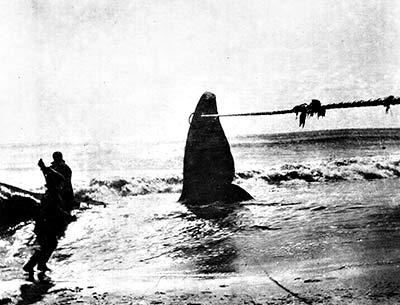Cannibalism, Two Ways

It’s 1820, the middle of the Pacific Ocean. Two sperm whales have been harpooned from the small boats launched from the whaler Essex out of Nantucket. A bull sperm whale does not like what’s going on. Enraged, it charges the Essex, ramming her bow twice. The ship fills with water, capsizes, and leaves her crew of 20 to head for the coast of South America a couple of thousand miles away in three boats with nothing but a limited supply of hardtack and very little water. Half die en route, the others barely survive by cannibalizing their fellow whalemen.
I just finished Nathaniel Philbrick’s “In the Heart of the Sea: The Tragedy of the Whaleship Essex.” The movie directed by Ron Howard hit theaters last week. Haven’t seen the movie, but I hope Howard interprets the “tragedy” in Philbrick’s title broadly enough to include the fate of the whales during a time they were being slaughtered for oil to light our lamps and even the beacon that reached out to sea from the Montauk Lighthouse.
The story of the Essex was well known in the 19th century. In fact, it fired the mind of a young whaleman named Herman Melville after he read the account of the sinking and the horrors of the crew’s subsequent fight for survival written by the Essex’s first mate, Owen Chase. Given the times, his account, and “Moby-Dick,” focused primarily on the human trials in the face of the cold, unmerciful power of Nature.
It would be interesting to see a comparison of the relative value, in economic terms, of the whale fishery of that time to the recreational fishing industry today. It’s apples and oranges, of course. Whaling itself was a purely commercial enterprise, while catching a fish is fun. It’s the supplying the means of the fun that has become a giant industry. The two fisheries share an almost religious belief in the right to pursue a natural resource.
I leave market fishing out of this equation because the 19th century could have been, and was, lighted by other than whale oil, but fish was, and continues to be, a primary source of food for much of the world.
Reading Philbrick’s well-told story coincided with the recent agreement among Atlantic coastal states to reduce the harvest of striped bass by 25 percent. The stock has rebounded from its collapse in the 1980s in large part due to careful management of both commercial and recreational fisheries, but the numbers are still huge. The commercial fishery has grown from 3.4 million pounds in 1995, to about 7 million pounds per year since 2004. The National Marine Fisheries Service and the Atlantic States Marine Fisheries Commission put the recreational catch at 19 million pounds in 2012.
Managers say that in pure numbers, the stock is not being overfished. However, the population of the female breeding stock has been hit hard. Computer projections suggested that if the fishing mortality rate were maintained through 2017, the spawning stock would be overfished. Studies show that a strong 2011 year class will help offset this trend. A 25-percent reduction in overall catch was recommended in deliberations by member states of the Atlantic Marine Fisheries Commission over the winter.
This will most likely translate to a catch limit of one striped bass per day measuring 28 to 34 inches, plus, if you’re lucky, one “trophy fish” measuring at least 36 inches. The one fish per day rule will hold for anglers aboard boats for hire who were permitted two fish measuring at least 28 inches in the past. The rules have been agreed to by New York’s neighboring states. This state’s recreational bass fishery is due to open on April 15.
It was heartening to hear veteran charter captains agree that an obscene number of large breeding females had been taken during the season. A number of the more responsible captains urged their customers to be satisfied with one fish despite what the regulations allowed for.
Fortunately, or unfortunately, even the biggest striped bass are not large enough to capsize a small boat full of fly-casters, leaving them no alternative but to eat each other. Then again, we are fast approaching a time when more of us realize that cannibalism does not refer only to human eating human. We are now painfully aware that the word also refers to the human race’s voracious appetite for the world’s resources.
